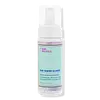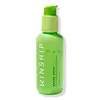What's inside
What's inside
 Key Ingredients
Key Ingredients

 Benefits
Benefits

 Concerns
Concerns

 Ingredients Side-by-side
Ingredients Side-by-side

Aloe Barbadensis Leaf Juice
Skin ConditioningWater
Skin ConditioningCocamidopropyl Hydroxysultaine
CleansingGlycerin
HumectantSodium Methyl 2-Sulfolaurate
CleansingSodium Lauroyl Methyl Isethionate
CleansingLactic Acid
BufferingPyrus Malus Fruit Extract
Skin ConditioningNiacinamide
SmoothingSorbeth-230 Tetraoleate
EmulsifyingDisodium 2-Sulfolaurate
CleansingLactobacillus Ferment
Skin ConditioningDecyl Glucoside
CleansingLauryl Glucoside
CleansingMusa Sapientum Fruit Extract
Skin ConditioningRubus Idaeus Fruit Extract
AstringentPyrus Communis Fruit Extract
Skin ConditioningPrunus Armeniaca Kernel Extract
Skin ConditioningMelia Azadirachta Leaf Extract
Skin ConditioningMelia Azadirachta Flower Extract
Skin ConditioningCorallina Officinalis Extract
Skin ConditioningCoccinia Indica Fruit Extract
Skin ConditioningSolanum Melongena Fruit Extract
Skin ConditioningAloe Barbadensis Flower Extract
EmollientCurcuma Longa Root Extract
MaskingOcimum Sanctum Leaf Extract
Skin ConditioningOcimum Basilicum Flower/Leaf Extract
TonicSodium Gluconate
Skin ConditioningHydroxyethylcellulose
Emulsion StabilisingSodium Laurylglucosides Hydroxypropylsulfonate
CleansingSodium Chloride
MaskingSorbitan Oleate Decylglucoside Crosspolymer
CleansingSorbitan Laurate
EmulsifyingSodium PCA
HumectantOpuntia Ficus-Indica Stem Extract
Skin ConditioningDisodium Phosphate
BufferingPanthenol
Skin ConditioningRiboflavin
Cosmetic ColorantSodium Hydroxide
BufferingPhenoxyethanol
PreservativeEthylhexylglycerin
Skin ConditioningPotassium Sorbate
PreservativeAloe Barbadensis Leaf Juice, Water, Cocamidopropyl Hydroxysultaine, Glycerin, Sodium Methyl 2-Sulfolaurate, Sodium Lauroyl Methyl Isethionate, Lactic Acid, Pyrus Malus Fruit Extract, Niacinamide, Sorbeth-230 Tetraoleate, Disodium 2-Sulfolaurate, Lactobacillus Ferment, Decyl Glucoside, Lauryl Glucoside, Musa Sapientum Fruit Extract, Rubus Idaeus Fruit Extract, Pyrus Communis Fruit Extract, Prunus Armeniaca Kernel Extract, Melia Azadirachta Leaf Extract, Melia Azadirachta Flower Extract, Corallina Officinalis Extract, Coccinia Indica Fruit Extract, Solanum Melongena Fruit Extract, Aloe Barbadensis Flower Extract, Curcuma Longa Root Extract, Ocimum Sanctum Leaf Extract, Ocimum Basilicum Flower/Leaf Extract, Sodium Gluconate, Hydroxyethylcellulose, Sodium Laurylglucosides Hydroxypropylsulfonate, Sodium Chloride, Sorbitan Oleate Decylglucoside Crosspolymer, Sorbitan Laurate, Sodium PCA, Opuntia Ficus-Indica Stem Extract, Disodium Phosphate, Panthenol, Riboflavin, Sodium Hydroxide, Phenoxyethanol, Ethylhexylglycerin, Potassium Sorbate
 Reviews
Reviews

Ingredients Explained
These ingredients are found in both products.
Ingredients higher up in an ingredient list are typically present in a larger amount.
Glycerin is already naturally found in your skin. It helps moisturize and protect your skin.
A study from 2016 found glycerin to be more effective as a humectant than AHAs and hyaluronic acid.
As a humectant, it helps the skin stay hydrated by pulling moisture to your skin. The low molecular weight of glycerin allows it to pull moisture into the deeper layers of your skin.
Hydrated skin improves your skin barrier; Your skin barrier helps protect against irritants and bacteria.
Glycerin has also been found to have antimicrobial and antiviral properties. Due to these properties, glycerin is often used in wound and burn treatments.
In cosmetics, glycerin is usually derived from plants such as soybean or palm. However, it can also be sourced from animals, such as tallow or animal fat.
This ingredient is organic, colorless, odorless, and non-toxic.
Glycerin is the name for this ingredient in American English. British English uses Glycerol/Glycerine.
Learn more about GlycerinLauryl Glucoside sugar- and lipid-based cleansing agent. It is created from glucose and lauryl alcohol.
This ingredient is a surfactant, making it easier to rinse oil, dirt, and other pollutants away.
A British study found lauryl glucoside to cause skin sensitivity for some people. We recommend speaking with a professional if you have concerns.
Other names for this ingredient include "Lauryl Polyglucose", "Lauryl glycoside", and "D-Glucopyranoside".
Learn more about Lauryl GlucosidePotassium Sorbate is a preservative used to prevent yeast and mold in products. It is commonly found in both cosmetic and food products.
This ingredient comes from potassium salt derived from sorbic acid. Sorbic acid is a natural antibiotic and effective against fungus.
Both potassium sorbate and sorbic acid can be found in baked goods, cheeses, dried meats, dried fruit, ice cream, pickles, wine, yogurt, and more.
You'll often find this ingredient used with other preservatives.
Learn more about Potassium SorbateThis is the synthetic salt of gluconic acid, a form of PHA and mild exfoliant.
It is mainly used to stabilize oil and butter formulations from going bad. Sodium gluconate is a humectant, pH regulator, and chelating agent.
Chelating agents help neutralize unwanted metals from affecting the formulation.
Sodium gluconate is water-soluble.
Learn more about Sodium GluconateWater. It's the most common cosmetic ingredient of all. You'll usually see it at the top of ingredient lists, meaning that it makes up the largest part of the product.
So why is it so popular? Water most often acts as a solvent - this means that it helps dissolve other ingredients into the formulation.
You'll also recognize water as that liquid we all need to stay alive. If you see this, drink a glass of water. Stay hydrated!
Learn more about Water